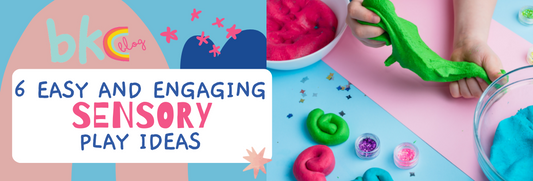Sensory play involves any activity that stimulates your little one’s senses – touch, smell, sight, sound, and taste. This sort of play is not just fantastic for babies, it has huge developmental benefits for toddlers as well. Read on to learn how sensory play can help advance your preschooler’s skills, and how to set up six easy and fun sensory experiences yourself at home.

You’re probably already familiar with the term ‘sensory play’. Maybe you’ve come across videos of sensory activities on your favourite mom (or dad) influencer’s Instagram, or seen some on your Pinterest feed. But have you ever actually tried any with your toddler? If you haven’t, consider this your sign from the universe to free up some time and create a sensory extravaganza for your child.
Don’t be deterred by how messy it all looks. Not all sensory play has to be messy. And even when it does require some clean-up after, the benefits far outweigh the cons. Sensory activities will keep your little one engaged for a precious bit – giving you time to finally finish that cup of tea or coffee while it’s still hot. More importantly, such activities help your little one’s language development, cognitive growth, fine and gross motor skills, and so much more. Here’s a look at some key benefits of sensory play.
What Are the Benefits?
Aids Cognitive Development
Sensory activities engage multiple senses simultaneously. Sensory stimulation in children helps develop their ability to explore and figure things out naturally. It all begins with observation: kids use all of their senses to explore the things around them. These sensory experiences then help them process and understand knowledge.
Develops Mathematical Concepts
Believe it or not, sensory play is a maths activity. Studies show that children are naturally inclined to engage in maths activities. They acquire early maths skills such as basic numeracy, shape differentiation, pattern recognition, and basic quantification.

Supports Language Development
Sensory play develops language and communication skills in children in different ways. For one, tactile-based play helps develop pre-writing skills such as dexterity and fine motor strength. Verbalising their sensory inputs helps increase a child’s descriptive vocabulary.
Teaches Life Skills
Through play, children develop multiple life skills required in daily life. For instance, when a child plays with rice, they learn how to scoop. Or when they play with water, they gradually learn how to pour. They learn skills – such as stirring, squishing, and kneading – which are later useful in practical life.
Encourages Creativity & Expands Imagination
As sensory play is open-ended, it helps kids create their own experiences, which builds neural connections in the brain allowing them to be creative thinkers and problem solvers.
Improves Mental Health
Sensory play has calming effects. It helps a child wind down or have some quiet time at the end of an active play session. These activities engage with their minds and help them regulate their emotions.
Sensory Activities for You to Try
1. Sensory Books
This is perhaps the easiest, most mess-free way to engage your child in sensory play. Bright, colourful books with textures and sound stimulate the sight, hearing, as well as the sense of touch. We particularly like Usborne’s Don't Tickle series, which is great for kids six months and up. You could try Don’t Tickle The Hippo, Don’t Tickle The Polar Bear, or Don’t Tickle The Dinosaur – depending on which animals are piquing your little one’s interest at the moment.
2. Sensory Bins
Surprisingly easy to create, sensory bins can be made out of any medium- to large-sized plastic container or tub. Add in a few toys and objects from around the house, and your little one is good to go. Kids will love feeling the textures of the bin’s contents and enjoy listening to the sounds they make when they rummage through them. Here are a few sensory bin ideas for you to try:
1. Fill your plastic container with uncooked rice, pasta, dried beans, or grains from your kitchen. Mix in some toy figurines and add a big plastic spoon or ladle for scooping. Don’t forget to lay out old newspapers or a mat under your container so spills can be cleaned up easily afterwards.
2. For kids who love to splish-splash in water, try water beads. Very easily available online, these tiny, colourful beads swell into soft balls when immersed in water for a few hours. Simply add a bunch of these to your container, along with some water and aquatic animal figurines, rubber ducks, or boat toys. Make sure to place a big towel under the container to keep spills in check.
3. We’re big fans of this third and last one, and you will be too! Pour water into your container and mix in some toddler-safe laundry or dish detergent. Then add any plastic toys that could use some cleaning – such as blocks or figurines – and a sponge or a soft scrubber brush. Let your kid splash around, play with the bubbles, and give the toys a scrub. Just make sure you lay out an old towel to catch any spilled soapy water. By the end of it, you’ll have a very clean set of toys, and a fairly clean toddler (don’t forget to rinse both off with water later!). Win-win!
Note: Safety first! Make sure to never leave your child unattended during these activities.

3. Slime
There’s something quite irresistible about the sticky, stretchy, and squishy texture of slime. It offers a chance for highly engaging sensory play, which kids of all ages tend to enjoy. However, with toddlers, you need to watch out for mouthing. If you’re worried your little one is going to want to slap some on their face or into their mouth, you might be better off creating a simple, edible slime at home with some cornstarch, water, and food colouring. But the feel of this DIY slime won’t be quite the same as a high-quality, store-bought one like these PodSquad slimes. These sets come with ingredients, stirrers, and cups to make slime – great fun for kids aged six and up – as well as things like glitter, small toys, and figurines, which add a whole other sensorial dimension for play. For younger kids, we recommend that you prepare the slime yourself and allow them to explore it while you are able to keep an eye on them.

4. Busy Boards
Also known as sensory boards or activity boards, busy boards are motor skill-based toys made up of household items like latches, light switches, knobs, zippers, wool, lace, wheels, etc. They allow kids to explore objects that may otherwise be forbidden to them in a safe, controlled manner. If you’re crafty, then you could try making one on your own using toddler-safe objects from around the house. But if you’re lazy like us, then you’ll find plenty of options online. A good busy board will help with your child’s fine motor skills and allow exploration of different textures and sounds.
5. Kinetic Sand
Easily available and easy-on-the-pocket, kinetic sand is super engaging and calming, even for adults! What makes it better than regular sand, in our opinion, is its smooth, flowy texture and the fact that it comes in some really attractive colours. Some sets come with moulds, but it’s absolutely okay if you get one without. Instead, you can offer your little one objects like measuring spoons, blocks, or small, plastic bowls to make an infinite number of shapes before squashing them with their tiny hands or ‘cutting’ them with a play knife. Both you and your kid are going to love playing with this one!
6. Gardening
Gardening stimulates the senses in so many different ways – from the coarse and sticky feeling of soil in one’s hands to the delicious fragrances of flowers and herbs. Among its many benefits, it teaches little ones lessons in cause-and-effect and makes them more empathetic towards the natural world. And your kid need not miss out if you don’t have a garden. Make the most of your balcony space or get some pots for inside the house, and include your toddler in activities like watering plants, picking herbs, or planting seeds (all under supervision, of course!).
As you would have gauged by now, sensory play doesn’t always have to be expensive, elaborate, time-consuming, or messy. And the tiny bit of effort that it may sometimes involve is well worth it when it comes to boosting your toddlers’ all-round development. So go ahead and indulge your toddler in some sensory play, and don’t be surprised if you end up participating enthusiastically yourself!





